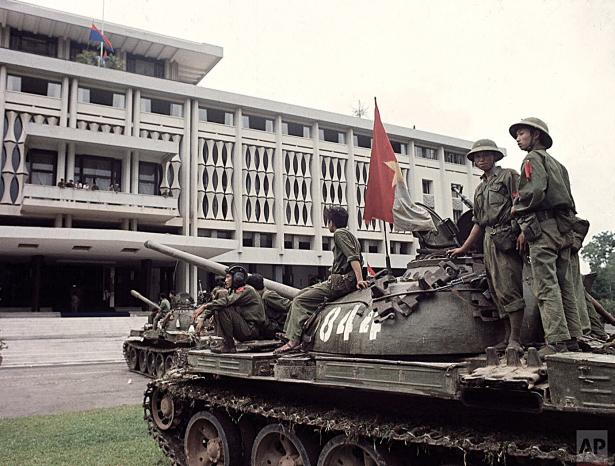Deadly and Dangerous, Imperialism Is, Indeed, a Paper Tiger
APRIL 30 IS THE 50TH ANNIVERSARY of the peoples’ 1975 victory over the U.S. attempt to subjugate Vietnam. Of all the vicious and prolonged bloodlettings for which the U.S. government has been responsible, surely the war against Vietnam is one of the worst.
Over 20 long years, in defiance of international law, the U.S. had been responsible for the death of many hundreds of thousands of Vietnamese patriots, some killed by starvation, some by air-dropped high explosives, some by the troops of the U.S. and its allies. At the same time, hundreds of thousands more were left permanently disabled by the premeditated U.S. attacks.
But finally, the government of the world’s richest and most powerful country had been defeated by the Vietnamese people’s brave determination to be free.
The last U.S. helicopter’s departure was like the belated answer to a 1964 prayer of Martin Luther King, Jr.: “This madness must cease. . . . I speak as a child of God and brother to the suffering poor of Vietnam. I speak for those whose land is being laid waste, whose homes are being destroyed, whose culture is being subverted. I speak for the poor of America who are paying the double price of smashed hopes at home, and death and corruption in Vietnam. I speak as a citizen of the world, for the world as it stands aghast at the path we have taken.” Visit the link to read all of MLK’s sermon, “A Time to Break the Silence” https://www.americanrhetoric.com/speeches/mlkatimetobreaksilence.htm
Turning Ugly Concrete Pillars into Things of Beauty
MAY 1 IS THE 55TH ANNIVERSARY of the end of a massive, militant and peaceful sit-in to prevent the construction of a large California Highway Patrol facility in the middle of Barrio Logan in San Diego, California.
The largely Chicano/Chicana neighborhood had already lost the use of the disputed land for housing when the California Department of Transportation had taken it over as the location of a massive highway intersection held up by tall concrete pillars.
Barrio Logan residents wanted to use the area that surrounded the pillars for recreational use, not a police station. After hundreds of people occupied the space continually for more than a week in 1970, city and state officials agreed that it would be devoted to recreational use controlled by the community.
The resulting 8-acre space, which is named Chicano Park, is now home to the largest collection of outdoor murals in the U.S., plus many sculptures. The murals cover many thousands of square feet of what was originally the bare concrete of the highway pillars. To view 93 of the murals and five sculptures, visit https://chicanoparkmuseum.org/murals/
When the War Came Home, Students Paid the Price
MAY 4 IS THE 55TH ANNIVERSARY of the Kent State University massacre, during which four unarmed students were killed and nine wounded when an Ohio National Guard platoon shot them, firing some 67 rounds in 13 seconds. All of the dead were students, either 19 or 20 years old. One of the wounded was left permanently paralyzed. Two of the dead were among some 300 students protesting the recent U.S. invasion of Cambodia; the other two were standing nearby, watching the demonstration.
Students and critics of the widening U.S. war against Southeast Asia were galvanized by the Kent State shootings. On the next day the student body of Brown University went on strike and six thousand University of Washington students in Seattle occupied the city’s 6-lane Interstate highway, shutting it down. A day after that more than 80 colleges all over the country, including all 28 campuses of the University of California and California State College were shut down for what then-Gov. Ronald Reagan called “a cooling-off period.” By week’s end more than 450 U.S. colleges had shut down.
Five days later, some hundred thousand people demonstrated against the war in Washington, D.C., in a protest that had been planned beforehand but was undoubtedly bigger and more militant than expected as a result of the shootings.
One campus that was not shut down after the Kent State shootings was the historically Black Jackson State University in Jackson, Mississippi, where, on May 14, two demonstrating students were killed and 12 wounded when fired on by police.
After both the deadly attacks on campus protests, the President's Commission on Campus Unrest was established. The Commission concluded that the wantonness of what it called "the indiscriminate firing of rifles into a crowd of students and the deaths that followed were unnecessary, unwarranted, and inexcusable" and that “the Kent State tragedy must mark the last time that, as a matter of course, loaded rifles are issued to guardsmen confronting student demonstrators.” https://truthtribunal.org/
An Anti-Racist Newspaper Celebrates Its 120th Birthday
MAY 5 IS THE 120TH ANNIVERSARY of the founding of the Chicago Defender, one of the most important and influential anti-racist newspapers in the U.S. The Defender was published weekly from 1905 until it became a daily in 1956. It returned to weekly publication in 2008, and switched to online-only in 2019. For much more information about the Defender’s history and influence, visit https://www.zinnedproject.org/news/tdih/chicago-defender-founded/
For more People's History, visit
https://www.facebook.com/jonathan.bennett.7771/


Spread the word